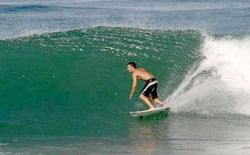Surf the Philippines and Discover the Most Exciting Surf Spot in the World
Surf the Philippines and you'll be in for a treat as you enjoy a surf spot with great waves and small crowds.
Philippine Department of Tourism (DOT) Secretary said that the water sport of surfing is one of the Philippines' most important markets for local and foreign tourists.
Lim made the statement during the recent Philippine National Surfing Convention held at the Club Manila East Resort in Taytay, conducted by the DOT and the Academy of Surfing Instructors Philippines, Inc. (ASIP).
The convention which is the first of its kind in Southeast Asia engaged the main stakeholders in the country’s surfing tourism industry in dialogues and other participative activities to attain clearly defined objectives for the advancement of this fast-growing water sport in the Philippines and the fastest growing personal sport in the world.
“The Philippines is now globally recognized as having some of the most exciting surf spots in the world.
"This convention paved the way for the introduction and subsequent development of surfing as a potent niche tourism product and a vital engine for socioeconomic growth while responsibly considering the sustainable preservation of the environment and the complete well-being of the local people in the host communities,” said Lim.
According to Director Elizabeth Nelle of DOT’s Office of Product Research and Development, the convention gave a total picture of surf the Philippines as a tourism niche market in the country vis-à-vis the rest of the surfing world.

Surf the Philippines |
It combined with the DOT’s overall thrust of optimizing positive as well as minimizing, if not totally preventing, negative sociocultural, economic and ecological impacts of tourism programs and projects on the local environment and the host communities.
Some of the local surfing spots currently popular with both local and foreign surfers are the islands of Siargao in Surigao del Norte and Calicoan in Eastern Samar as well as the beaches of San Juan in La Union; San Antonio, San Narciso, San Felipe and Iba in Zambales; Baler in Aurora; Real in Quezon; Puraran in Catanduanes; and Lanuza in Surigao del Sur, among others.
With more than 7,107 tropical islands in the Philippine archipelago, there are still several surf the Philippines sites yet to be explored for their surfing potential.
“During the convention, impressive revelations about surfing were presented which came as a surprise to many. A sample of these revelations included the fact that in the last two years alone, no less than 7,000 surfing enthusiasts finished their individual surfing lessons -- given by only three of several local surf schools - and are now active surfers.
"Surfing maybe undisputedly the fastest growing personal sport in the world. With this scenario, we have started with the establishment of rules and regulations as well as the mechanism to rationalize and monitor the surf the Philippines industry,” Paolo Soler, ASIP chairman said.
Based on data supplied by ASIP, the convention’s main proponent, there are over 10 million surfers in 50 countries worldwide.
Of these total number, a conservative estimate of 350,000 surfers are cash-rich professionals who regularly travel mainly to surf and are always looking for more exciting surfing sites to challenge themselves.
From being worth slightly over US$ 2.5 billion in the 1990s, surfing tourism is growing at an astonishing rate of 12 percent to 16 percent annually.
In neighboring Bali attracted some 1.7 million surfers who contributed about US$ 2.4 million or a staggering 37 percent of Indonesia’s total tourism revenue. (PNA/Lily O Ramos)
The Best Philippines Surfing Spots


